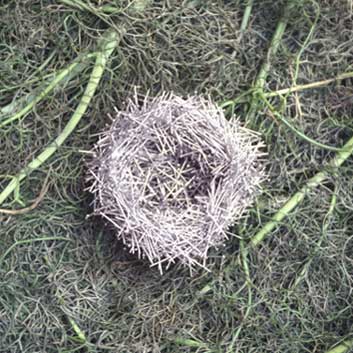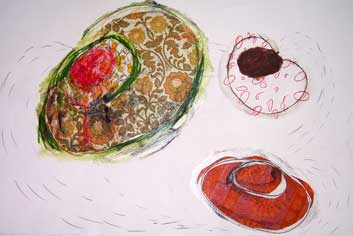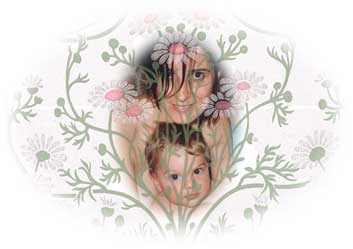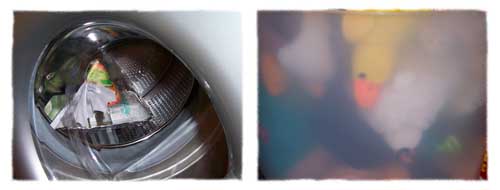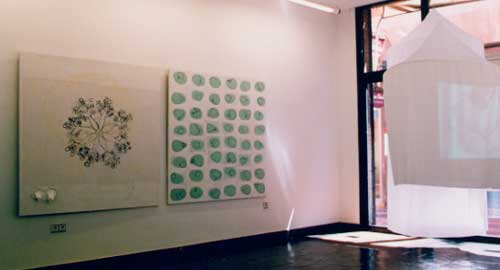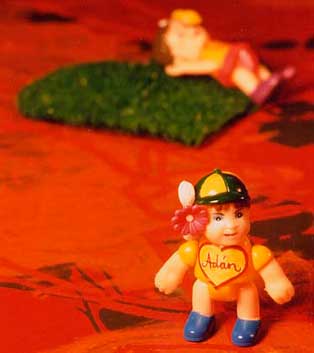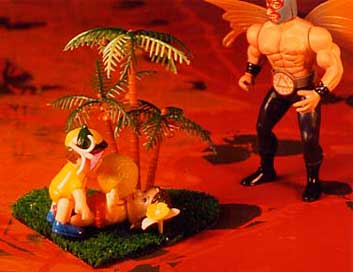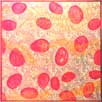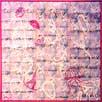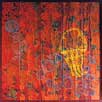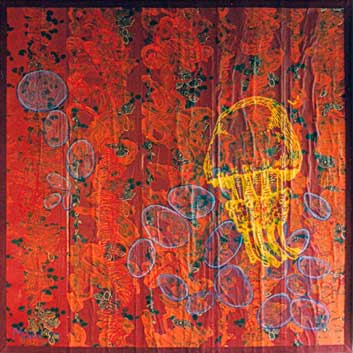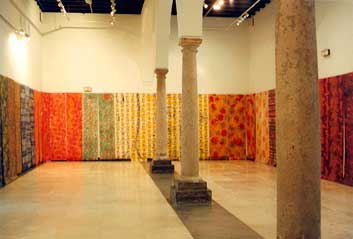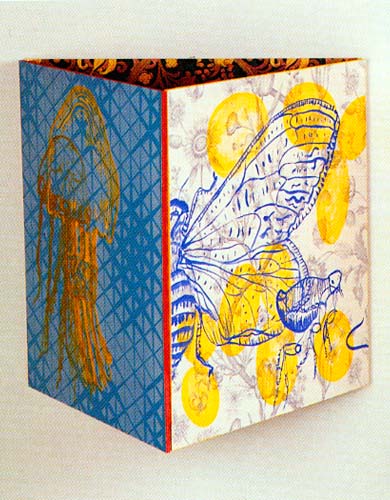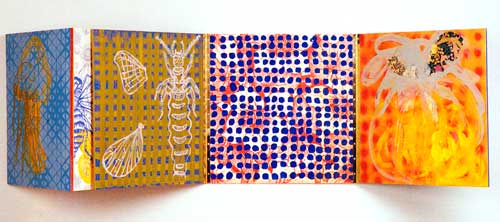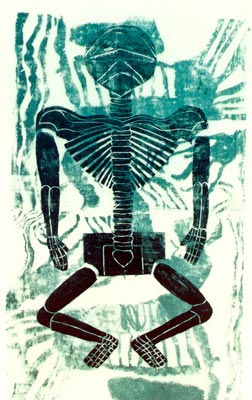Los nidos representan, para la artista, las múltiples y diferentes relaciones que se establecen entre una madre y su criatura. Nidos -objetos y dibujos- que rompen ese ideal maternal artificial, unívoco y culposo según el cual la madre sería siempre igual: dispuesta, abnegada, una prolongación de las necesidades de su hijo o hija. Partiendo del carácter relacional de la experiencia materna, la artista da cuenta de esa multiplicidad: relaciones afiladas, hirientes; relaciones que curan; relaciones heladas, calculadas; relaciones físicas, entrañables; relaciones que abren o cierran puertas; relaciones que conectan; ... La autora insiste en que no se trata de atribuir a cada experiencia materna un tipo de relación de por vida, sino que son, todas ellas, diferentes estados de ánimo, momentos, etapas por las que discurre la aventura del reconocimiento entre una madre y la singular persona que ha traído al mundo. Relaciones, como muestran las fotografías, que circulan entre el pensamiento y las entrañas, deshaciendo la falsa oposición jerarquizada entre mente y cuerpo, integrando razón y sentimientos en un continuo. Continuidad que abre las puertas al mundo, a la cultura y la sociedad, alejando al hecho materno de esa construcción biológica, muda y meramente instintiva en la que demasiado a menudo se lo ha querido encerrar. Lecturas y reflexiones que Mónika ha utilizado para su trabajo, inciden en la historicidad del sentimiento materno, en cómo en diferentes coordenadas espaciales y temporales se han atribuido a la maternidad muy distintos valores y actitudes. Esther Moreno (del texto del catálogo)


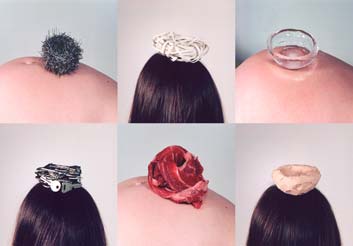
Nest Syndrome
Photography, drawings, objects and videos.
Juana Francés Hall, Zaragoza City hall
Monika Rühle refers to the concept of the nest syndrome as the impulse that a woman feels from the moment of her pregnancy to prepare herself and her environment for the welcoming of her new born baby.




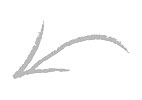

Nests in their habitat
Photography
An archive of artificial nests. There are approximately 20 nests that have a similar size to that of a sparrow's. The nature of these nests if often artificial and there is a strong clash between the nest and its environment. Often the nest doesn’t fit into its’ surroundings, an intrusion occurs.
La naturaleza del estos nidos es a menudo muy artificial y se produce un choque entre nido y entorno. Muchas veces no encaja un nido en el medio, se produce un intrusismo. El propio nido ocupa un lugar que no le corresponde. Esta serie de diapositivas consiste en posibles localizaciones para estos nidos en diferentes espacios de mi jardín. La búsqueda de un lugar imposible para asentar un falso nido.


Nests of feelings
Drawings, each 114 x 75 cm large, mixed media.
The nest reflects the complicated and complex emotional relationship between mother and child; instincts and desires, its moments of great happiness, understanding and love, and also the difficult task of educating. The feelings are the source for the bonding of the relationship between mother and child.
Serie de dibujos de 114 x 75 cm
Técnica mixta

Happiness
Installation and photography
The images are stamped on a hanging cloth in the form of a curtain. Inside you will find a painted wall covered with memories: objects, framed photos, drawings, autobiographies. It’s my private space.
I have elaborated some images made up from my personal album, of treasured moments shared with my children, with drawing of painted papers that I used in previous series since 1996. The images are sweet and intimate, sincere and real combined with exuberant floral designs for the 70´s.

Domestic Poetry
Photography
Chanel Isabel II, Madrid, The Evil of Archive... XII Conference on Image
An archive of images from my daily family life. They are little moments of happiness. What is a home? Could it be a place, a stack of things, or people who live there, constantly transforming it?
These images witness a constant change of state of intense experiences. It’s an attempt to reflect my environment, my life in those moments of family life; to show how a certain space portrays its habitants and is constantly victim of their lives. Nothing is what it used to be.

The mystery of the milk
Installation
La Aurora Gallery, Murcia
Paintings, screen prints, objects and video.
Thoughts on breastfeeding. The audience enters a room shaped as breast and see a video projected from inside. On the floor there are two huge breast made from white imitated leather. They are actually poufs where you can lie down and listen to a soft German lullaby irradiate from within. On the walls; an apron, a waistcoat and a tie. Multiple breasts hang in a row reminding us of udders brimming with milk.
Material: video "Misterio de la Leche" proyectado sobre una escultura de tela, 2 pufs en forma de pecho, vestuario colgado en la pared, pinturas y serigrafías.

Paradise
Installation
Art Fair ESTAMPA Temptations Showrooms, Madrid
Slide projection on gauze
The photo romance Paradise is made up of 80 slides where the happy couple spend their adventurous lives together. From the creation of Adam, Adam’s rib operation, the creation of Eve, episode with the tiger, encounter with the Almighty, reforestation of Paradise, through to expulsion and finally a happy ending.
The photo romance with plastic dolls is set on a painted backdrop with its warm tones reminds us of a biblical hell.
The 80 slides are projected in a closed space on 5 stretched tulle curtains. The picture is replicated in space and increases with the distance. Visitors can enter into the installation and feel themselves totally submerged in a coloured space.

Fragment of Paradise
Paintings, objects and photography
La Escalera Gallery, Cuenca
Here the Wallpaper of FLOOD is mounted on canvas and as an independent "image" re-edited. I had painted for flood hundreds of meters of colourful flower-wallpaper with protozoa and insects. They now form part of my project paradise together with the photo series Paradise, retelling a free adaptation of the story of Adam and Eve.
These insects are walking around here so boldly on the colourful murals. They are actually derived from the biology book. These extravagant designs on wallpaper represent their natural environment, their personal world. These tiny creatures have souls. Undoubtedly, the origin of their wings is a divine trick.
Because of India's Jain religion minerals have a soul, plants have two, animals and people even three.

Locus Amoenus
Installation
Cultural Foundation Ramón Puyol, Algeciras and Gallery 22, Stuttgart
Acrylic painting on wallpaper. Variable dimensions.
I have painted on wallpaper single-celled organisms, protozoa, insects and aquatic animals. The idea was to totally flood the room.
Wallpapers have fascinated me since my lino-series ARCA in 1995, but they got my passion with the installation of Hostal Roca in 1996. Since then I've painted on hundreds of meters of wallpapers with extravagant floral patterns from the 60s and 70s. The installation consists in strips of wallpaper hanging from the ceiling, that fills the walls completely, thus creating the illusion of flooding.

The Angels
Paintings
Acrylic painting on painted paper placed on a three board mobile triptych. Extended size 180 x60 cm.
Circuits of Young Art from the Madrid Community, exhibition tour at the Centre for Young Art Madrid, Barcelona, Valencia, Oviedo, Pontevedra, Salamanca, Granada, Bremen and Berlin.
Angels have wings, at least in medieval paintings. What else are insects but small winged messengers? The metamorphosis of the butterfly appears with the hermetic and protected eggs along side parasites such as fleas and lice.
El soporte de tríptico no fue una elección casual. ¿Acaso esconde el retablo en su interior más ángeles? Estoy recuperando la tradición de la pintura-retablo, la búsqueda de lo sagrado ligado al arte, pero desde un contexto contemporáneo consumista destinado a reciclar.
Pintura acrílica sobre papel pintado montado sobre tríptico móvil en tres tableros, abierto 180 x 60 cm.

Hostal Roca
Installation
Centre for Young Art Madrid
"When I found in my studio remains from the old abandoned hostel, HOSTAL ROCA, I started to imagine the lives of its residences. The rooms were fully furnished and equipped with incredible wallpapers. In each room there was a closet that includes many personal objects of the former residents. The wardrobes of the ten tiny rooms were crammed with all sorts of junk: X-rays, clothing, photos, drugs, lottery tickets, toiletries, etc. " The series of four bedside tables reflects the situation of isolated living cells. There are floating reminders of a past reality, captured in time. A video with footage from the old hostel went in a closet that was lying on the floor.

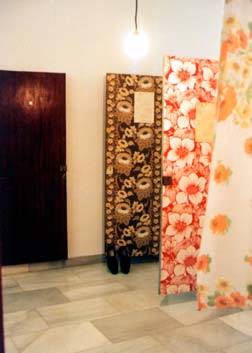
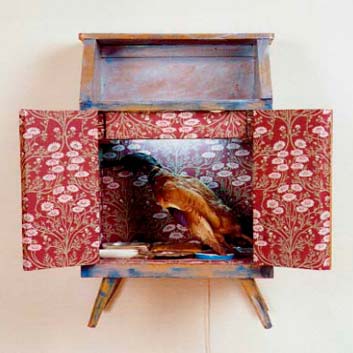









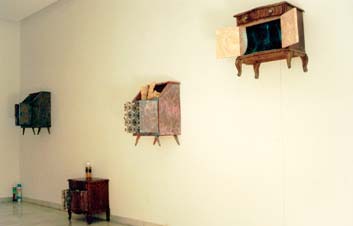
En general, la práctica artística de la instalación casi la ha convertido en el ‘hipergénero dominante” (G. Solana) en nuestros días, pero algunas de ellas, en las que se advierte un
dominio maestro del género, tienen, nunca mejor dicho, “cosas” que decir. Es el caso de “Hostal Roca”, una grandiosa instalación con la que Mónika Rühle ha ocupado la sala inferior del Centro de Arte Joven de la Comunidad de Madrid –y también ha llenado buena parte del espacio artístico reseñable en esta ciudad-. En “Hostal Roca” aparecen recopilados y dispuestos algunos de los efectos ersonales y enseres domésticos, algunas de las “cosas” que dejaron abandonadas hace unos años, después de un desalojo forzoso, los habitantes del verdadero Hostal Roca, de Madrid. En “Hostal Roca”, a mí parecer, está artísticamente muy bien resuelta, con un estilo vigoroso, la eterna cuestión artística de las relaciones entre el signo y lo significado, que, por influencia, entre otras cosas, del
postestructuralismo, lleva unas décadas compareciendo –tanto en la teoría como en la praxis artística- de modos nuevos, que se muestran recisamente en las instalaciones.
Lo primero que llama la atención en “Hostal Roca” es que la relación de M. Rühle con el Hostal Roca no es la misma que la relación de M. Rühle con el “Hostal Roca”. La primera de esas relaciones es personal y probablemente le pertenecieron, la nostalgia, el sentido de la brevedad de la vida y del efecto sobre las pobres cosas humanas del tiempo, “el enemigo que mata huyendo” según Quevedo: la artista llegó al Hostal Roca mientras buscaba un taller para alquilar (de hecho, su estudio está ahora allí), y se encontró todo aquello como si hubiera sido recién abandonado: todo estaba como si quienes usaron y
vivieron y dieron sentido a todo aquello hubieran salido un día normal a una hora corriente; solo que — como el Wakefield de Hawthorne — no volvieron jamás.
Pues es justamente el trabajo artístico en la ambigua tierra de nadie que queda entre esas dos relaciones lo que constituye, a mi parecer, lo especifico del género de la Instalación frente a la figura paradigmática de la modernidad clásica (el cuadro), y ese
es el tipo de trabajo magníficamente llevado a cabo en este caso.
En “Hostal Roca”, el juego artístico entre cosas y signos (el par que ha sustituido en la conciencia postmoderna a más clásico de naturaleza / artificio) está curiosamente alterado. Lo propio de los signos es que viven fuera de sí mismos, puesto que son
signos de algo (de una cosa o de otros signos); lo propio de las cosas, en cambio, es que solo viven en si mismas. Un cuadro de, digamos, una escena campestre, “representa”, pero naturalmente no es lo representado, sino un signo separado de la cosa significada. En una instalación, en cambio, curiosamente, signos y cosas están separados y al mismo tiempo unidos: lo característico de la instalación es que su escenario esta constituido por cosas que cohabitan con sus signos (y viceversa); manipulado con intencionalidad artística, ese tipo de “escenario” (M. Rühle ha trabajado también, aparte de pintando, en la ambientación de piezas teatrales) acaba poseyendo la atmósfera típica de la instalación: la de una ambigua hiperrealidad. Cuando accedemos a ella, sabemos que asistimos a algo hecho con intencionalidad artística, sin embargo, lo que encontramos allí son “cosas”, y tan ordinarias y corrientes que nos resulta difícil atribuirles algún carácter de signo; nos hace interrogarnos si los objetos “instalados” remiten a otra realidad, si significan algo distinto de si mismos, o no lo hacen. Si son signos o cosas.
La respuesta, en el caso de “Hostal Roca”, es necesariamente ambigua, y lo es porque los signos (por ejemplo, estos espejos que contemplamos ahora en “Hostal Roca”) que remiten a las cosas (precisamente a aquellos espejos que estaban en el Hostal Roca) son las propias cosas- no estamos ante su representación pictórica sus imágenes, sino ante ellas mismas. “Hostal Roca” es ‘inseparablemente una ambigua reunión de signos artísticos con objetos corrientes. Y una gran instalación, a medias entre lo real y lo fantástico. Como el mundo…
MANUEL FONTÁN DEL JUNCO

Descubrimiento-discovery
Installation. Woodcut print series of 2 x 1 m high, on tracing paper.
2003 Culture Center City Hall Moralzarzal, Madrid
1993 Künstlerhaus Stuttgart
1992 Chapelle des Cordeliers Sarrebourg, France, Piazza Gallery Nuremberg and Art School University of Barcelona
Referring to the five hundredth anniversary of the discovery of America, linking the discovery of the human body with the discovery of the New World. anatomical drawings of medieval manuscripts from China, India and France were used as a source of inspiration.
.
![]()

















